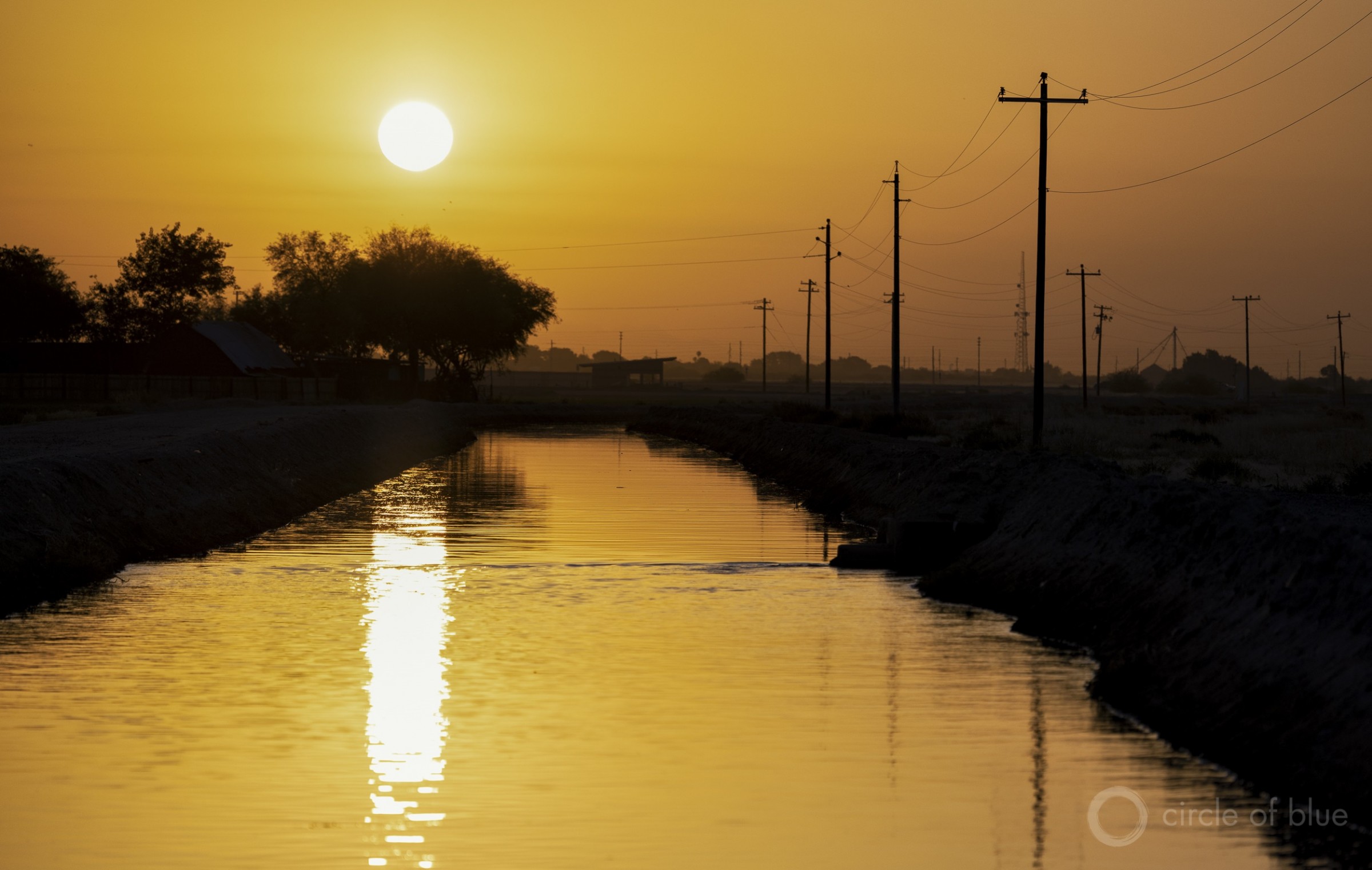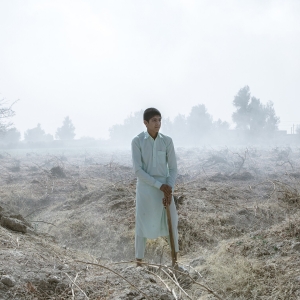The Stream, May 1, 2024: In Sri Lanka, Contaminated Waters Linked to Kidney Disease in Farmers

The sun illuminates a canal in Buckeye, Arizona. Photo © J. Carl Ganter/Circle of Blue
YOUR GLOBAL RUNDOWN
- For decades in Sri Lanka farmers have suffered from kidney pain and failure, the cause unknown though likely linked to contaminated water.
- The last sugarcane mill in Texas has closed, as its water needs were too great for the drought-stricken region.
- Water levels have become so low in the Philippines that a formerly submerged town, now a symbol of drought, is once again visible.
- In Arizona, a traditionally Republican state, voters are considering candidates’ stances on water access and ownership with increasing scrutiny ahead of this year’s elections.
Heavy rainfall and landslides in Kenya have forced nearly 200,000 people from their homes and killed more than 100.
“When I opened the door, the water gushed in and made its way through the kitchen. My husband managed to quickly maneuver and get out. My daughters who were in the next room were swept out of the house by the force of the water.” — Anne Gachie, resident of Mai Mahiu, Kenya.
At least another 84 people remain missing this week as rescuers shovel through the mud deposited by landslides across Kenya, Reuters reports. Cars, homes, and trains have been destroyed and swept away in the intense, sudden deluges, made more extreme by climate change. The collapse of a dam in Mai Mahiu, after weeks of rising waters, sent water spilling across the Rift Valley.
The majority of the evacuations have occurred in the capital Nairobi, a city of 4.3 million people, with 147,000 relocating to safer shelter. In March and April combined, 169 people have died due to the rains in Kenya, while in nearby Tanzania and Burundi, dozens more have been killed and hundreds of thousands of people displaced.
— Christian Thorsberg, Interim Stream Editor
Recent WaterNews from Circle of Blue
- Despite $Billions Spent, Tide of Harmful Farm Pollutants Grows Ever Larger — “Best management practices” are not impeding flow of farm nutrients into nation’s waters.
- Sault Tribe Challenges Michigan Fishing Deal, Chides ‘Preposterous’ Rules — The tribe argues they can’t be forced to follow rules crafted without their consent.
The Lead
Researchers in Sri Lanka are investigating why a growing number of people are suffering from cases of “chronic kidney disease of unknown etiology,” known as CKDu, Al Jazeera reports. In regional hotspots across the country, as many as 23 percent of residents have been diagnosed with the affliction, which has no obvious causes.
It is likely, however, that toxic agrochemicals are playing a role, scientists hypothesize. They have found geographic links between disease hotspots and irrigation water, and it is mainly men — who tend fields of rice paddies and other crops, and rely on aquaculture and fishing — who are experiencing symptoms of back pain, swelling, and aches.
In farming communities, those who are able switch from drinking groundwater to filtered water, though few have the financial means to do so consistently. Others are still using groundwater to cook and clean. An economic downturn has also forced community members to ignore their own health, taking pain-killers while continuing to work in polluted conditions.
Meanwhile, chronic dehydration amid rising temperatures across Sri Lanka is worsening poor health. Among fishermen, the tradition of drinking liquor to quell seasickness compounds the negative health effects.
Some families are opting to boil their groundwater, which experts say helps to remove bacteria but not toxic concentrations of pollutants, which include calcium and fluoride. More education is needed, scientists urge, to institute healthier practices, though they acknowledge that it is difficult to affect lifestyle changes without financial freedom.
This Week’s Top Water Stories, Told In Numbers
60
Percent of voters in Arizona “who believe the state is running out of water,” according to a survey by Noble Predictive Insights, the New York Times reports. This anxiety has prompted Democrats to seize on water rights and access as major talking points ahead of the 2024 U.S. elections, particularly in small and rural counties where groundwater pumping to irrigate crops has in some instances caused entire towns to sink some five or more feet. For those whose wells are going dry and have witnessed private landowners — including foreign-owned companies — control or attempt to control part of the region’s water supply, candidates’ stances on water may influence voting this November.
In context: The Biggest Dry: Arizona
29
Average inches of rainfall per year in the lower Rio Grande, compared to the 50 inches of water, at least, sugarcane fields need to grow, the Guardian reports. As a result of this discrepancy, made worse by a megadrought in the south Texas borderlands and Mexico, the state’s final sugar mill has closed. Even with irrigation, water needs across the 34,000-acre Texan co-op couldn’t be met. Obligated by a 1944 treaty to deliver 1.75 million acre-feet of water to the U.S. in a five-year cycle, Mexico, plagued by drought, couldn’t deliver either. “It’s not that Mexico is holding the water because they are bad neighbors,” Texas A&M agricultural economist Luis Ribera tells the Guardian. “They’re using it.”
In context: Can U.S. and Mexico Secure Water Supplies in Shrinking Rio Grande?
On the Radar
The 300-year-old Filipino town of Pantabangan, submerged in the 1970s to construct a reservoir, has re-emerged amid prolonged dry conditions and extremely low water levels, BBC reports. Nearly half of the Philippines is currently experiencing drought, and the town — which draws visitors whenever visible and has come to be a symbol of water scarcity — has never been above water for this long. From a normal level of 221 meters, the water level is sitting at 50 meters, officials say. Temperatures in excess of 113 degrees Fahrenheit in the country and across Myanmar, Thailand, and Bangladesh have so far killed dozens of people this year.
More Water News
Goldman Environmental Prize: Seven international recipients have been awarded this year’s “Green Nobel” for their grassroots environmental activism, including efforts to block mining, protect biodiversity, and safeguard waters and local heritage, Mongabay reports.
Vietnam’s Coffee Growers: According to a new report from J. Ganes Consulting LLC, growers this season have irrigated their coffee trees more often than normal amid a regional heatwave, and are now running low on water, Reuters reports.
Christian Thorsberg is an environmental writer from Chicago. He is passionate about climate and cultural phenomena that often appear slow or invisible, and he examines these themes in his journalism, poetry, and fiction.






Leave a Reply
Want to join the discussion?Feel free to contribute!